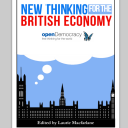Falling house prices could be the reboot our economy desperately needs. But only if we prepare for a soft landing

Image: Images Money, CC BY 2.0
The housing market seems balanced on a knife edge. In January house prices fell for the second month in a row and buyer enquiries fell for the tenth consecutive month. Some commentators are calling for governments to ‘loosen monetary policy’ and ‘reinstate tax incentives for real estate investment’ in order to head off the risk of a crash. But excessive mortgage lending and real estate speculation helped get us into this mess, and more of the same is not going to get us out. If the government (or government in waiting) is serious about fixing the housing crisis, then it must get ready to give the housing market a soft landing.
Our lack of preparedness for dealing with a downward adjustment in house prices is a key obstacle to meaningful housing system reform. Take the issue of rent controls – by far the swiftest and most effective way to address the insecurity and exploitation in the Private Rented Sector. Rent controls are commonplace elsewhere in Europe, and polls show there is broad public support for them in the UK. They could take the form of strong tax penalties for landlords who charge more than a “living rent” (say, 30% of lower quartile earnings), alongside rent stabilisation measures, which would prevent landlords from raising rents faster than price or wage inflation. To give renters the additional peace of mind that they will not have to uproot at short notice – pull their kids out of school, leave behind jobs, friends and family – we could also have minimum five year tenancies, or better still, an end to ‘no fault evictions’, as implemented in Scotland last month.
Why do these proposals have so little traction in Westminster? Vested interests and ideology clearly play a role, but for many the reluctance to improve renters’ rights is borne out of fear – of triggering a sudden flight of investors and with it a crash in house prices.
This is not an unreasonable concern to have. The Buy To Let frenzy and loose mortgage lending of the last two decades have left us in a highly exposed position, with a long way to fall: prices in London are now 22% higher in real terms than they were at the height of the 2007 bubble, and a fifth of the UK housing stock – around 5.5 million homes – is in the hands of investors. As the Bank of England has repeatedly warned, this high concentration of investors carries with it the risk of a more sudden and dramatic house price fall: houses which are primarily conceived of as financial assets rather than homes are readily put up for sale if they no longer present a good investment.
A dent in rental income will be most concerning for those landlords who are servicing outstanding mortgages – which is the case for somewhere between 49 and 77 per cent of UK landlords. If a chunk of these opt to sell, it is unlikely that the spike in supply would be easily absorbed. Quite the opposite: if there is improved security and affordability in the Private Rented Sector, many potential first time buyers could decide to postpone their purchase decision until the dust has settled post-Brexit.
Unfortunately, high levels of mortgage debt make the UK economy uniquely vulnerable to a house price adjustment. Low interest rates and weak supervision of mortgage lending have enabled loan-to-income ratios to creep even higher than they were in 2007. Thus, a price fall could push a hundreds of thousands of households into negative equity, making it difficult to either move house or remortgage. This would be particularly problematic for those coming to the end of teaser deals and facing expensive Standard Variable Rates. Mortgage defaults could in turn affect the solvency of major banks whose balance sheets are now dominated by mortgage loans.
Once prices begin their descent, the feedback loops that push prices up during a boom could quickly slip into reverse. Banks could become far more cautious about extending mortgages, and households could become far more cautious about buying, which would put further downward pressure on prices. Meanwhile, households worried about their fall in housing equity may cut back on consumer spending, leading to falling profits and dampened business confidence.
With this domino effect in sight, is it any wonder that successive governments have dragged their feet on effective housing reform?
But what if we could intervene to ensure that prices fell in a controlled and gradual way? What if we could ensure that first time buyers who bought at the height of the boom were protected from negative equity, and that houses put up for sale by investors were bought by ordinary renters and not by second home owners? In that scenario, wouldn’t a reduction in housing costs be just the ‘reset’ that our economy needs, in order to better serve the interests of society? It would mean a smaller proportion of future household budgets eaten by landlords and banks. It would address one of the major blockages on the supply side of the housing system – the high price of land. It would begin to reverse the socio-economic cleansing of neighbourhoods that has occurred over recent decades.
What might such an intervention look like? How do you burst a bubble in slow motion? One idea that might be worth exploring is a People’s Land Trust and Building Society[*] (PLT hereafter) – a publicly backed but independent non-profit institution which would buy land from underneath houses and lease it to members.
There are two groups likely to be interested in leasing land, instead of owning it. The first is highly indebted homeowners who could sell the land from underneath their homes to the PLT, and use the income to pay down their mortgage debt. This ‘mortgage rescue’ element would help to protect banks and building societies from defaults and debt write-downs.
The second is people who want to be homeowners (privately or mutually) but cannot meet the current mortgage deposit requirements. Households or housing coops could approach the PLT when they’d found a house they wanted to buy and ask the PLT to cover the cost of the land and to grant them a mortgage to cover the cost of the bricks and mortar. Since bricks and mortar can account for as little as 30% of the price of a property, this would require people to save much lower deposits than is conventionally the case. Like the first group, the new buyers would sign a lease with the PLT which would entitle them to exclusive and indefinite use of the land in return for paying a land rent.
A PLT could thereby create a pool of renters ready and able to buy as soon as investors decide to sell, mitigating the risks of a precipitous fall in prices and a sudden shortage of rental properties. We can think of the PLT as a lever for introducing ‘desirable’ sources of demand into the market as ‘undesirable’ (speculative) sources of demand are exiting the market. In this way, the PLT could make all sorts of other housing and land reforms – such as the introduction of a Land Value Tax – more feasible too.
Depending on how it was financed, the PLT would sooner or later start to run a surplus which could be used to proactively purchase land for social housing, and/or be partially redistributed as a dividend to all members who have been paying into the PLT for some minimum number of years – 25 years, say. The latter option could improve the attractiveness of PLT membership compared to the mainstream model of homeownership.
Of course, if people wanted to leave the scheme before this point they would be free to go. When moving house, members of the PLT would sell only the bricks and mortar. The land itself would remain in the Land Trust, and the lease (and obligation to pay land rent) would transfer to the new occupant.
There would be no scope for making windfall gains or unexpected losses from such a sale, because land rents would be adjusted in line with changing land values, with the explicit aim of making sure that the sale price for the bricks and mortar remained roughly stable. This adjustment is essential to ensure that changes in the value of land do not result in arbitrary rewards or punishments for homeowners who have done nothing to deserve either. However, to protect PLT members from unexpected hikes in land rents (e.g. in the case of a gentrifying area), land rent increases could be capped in relation to wage inflation and only fully adjusted when the property changed hands.
To summarise, the purpose of the People’s Land Trust and Building Society would be to:
- protect ordinary households who bought at the height of the boom from ending up in negative equity.
- make it possible for people to own their own bricks and mortar without buying the land underneath.
- improve financial and macroeconomic resilience, by reducing the likelihood of mortgage defaults and making house price adjustments more gradual.
- allow for the gradual socialisation of unearned land rents which are currently captured privately by banks and landlords.
Needless to say, there are numerous questions to resolve in relation to this proposal. Perhaps the most obvious is the question of how the PLT ought to be financed: options could include bond issue; borrowing through the Public Works Loans Board; Strategic Quantitative Easing; a Land Value Tax, or taxation of the capital gains and rental income of property investors. The form of finance will obviously have a bearing on how quickly the PLT can grow and deliver a surplus.
There are challenges to overcome in relation to the valuation of land in periods of economic adjustment. And in the case of households who wished to sell their land to the PLT in order to pay down debt, there is the added dilemma of whether they ought to be remunerated for their land at the price they paid during the boom, or at contemporary (lower) values. The former option would seem fairer in the case of first time buyers who would not have benefitted at all from the preceding boom through ownership of previous properties. But of course, if the PLT were to buy the land at its value before house prices began to decline and then charge a land rent in proportion to new lower land values, it would take longer for the land rents to cover the PLT’s initial outlay.
There is also the challenge of ensuring that the separation of land and housing does not make it difficult for people to move house, as Shared Ownership schemes have sometimes done. If a new buyer could not be found to buy the bricks and mortar and take on the land lease, one option might be for the PLT to offer to buy the bricks and mortar at a price determined by independent Chartered Surveyors, and then sell it at a discount to social housing providers.
And finally there is a question about how the scheme would operate in the case of flats, where ownership is of a leasehold, and not a freehold. Perhaps the scheme could precipitate an end to leaseholds altogether?
The purpose of this article is to not to present a perfectly polished proposal, but to stimulate discussion. There is a risk, I realise, that the complexity of the challenges presented here might induce some readers to put their heads in the sand. Some might be thinking to themselves: ‘Perhaps we can solve the housing crisis without affecting Buy To Let profits?’ This is delusional on several levels.
High rents are inhumane: they mean children growing up in overcrowded, damp and unsafe conditions, and workers wasting hours every day on the commute. High rents are a drain on public resources: every year £8 billion of public money is paid out to private landlords in housing benefit. And high rents are driving a wedge through society. Until the 1980s, the housing costs facing renters and homeowners were broadly similar. Today, average private renters hand over twice as much to landlords as mortgaged homeowners hand over to banks in interest.
There are faster or slower ways of addressing these injustices. Theoretically, a massive state-led house building programme would, eventually, reduce pressure on the Private Rented Sector and improve tenant bargaining power. But there is a huge backlog of housing need to address (DCLG estimates as many as two million households) and major skills shortages in the building sector, to mention just two of the potential hold ups. We don’t have time to wait for these hurdles to be cleared. Rent hikes and evictions are ruining lives now.
It is time to face reality and listen to the demands of increasingly organised renters – in London, Scotland, Bristol and beyond. Rents must come down, security of tenure must be improved, and we must prepare for the long overdue bursting of the UK’s housing bubble. This means finding a way to cancel the unpayable debts of homeowners in negative equity, prevent banking insolvencies, and ensure that it is ordinary renters – and not second home owners – who benefit as investors flee the market. The People’s Land Trust may not be the answer. But it is time for fresh and bold thinking in this direction – or the societal fault line that has opened up between property haves and have-nots will only continue to widen.
[*] The idea presented here was originally inspired by a draft paper from the New Economics Foundation, making the case for a gradual but mandatory separation of the ownership of land and housing. See McCann et al. (forthcoming). Modern Land Reform. New Economics Foundation.





